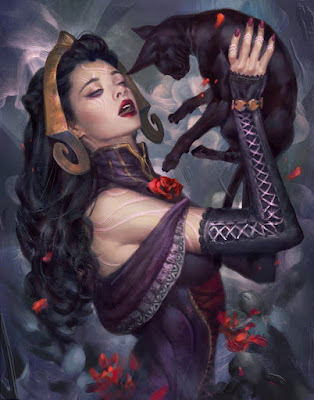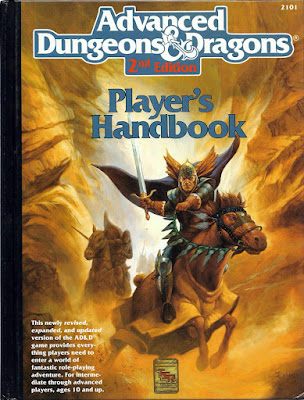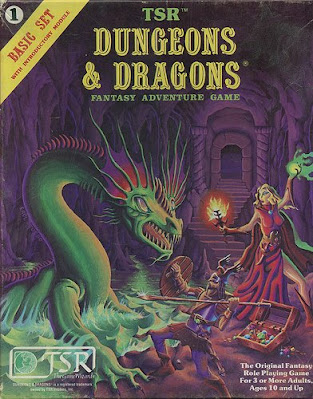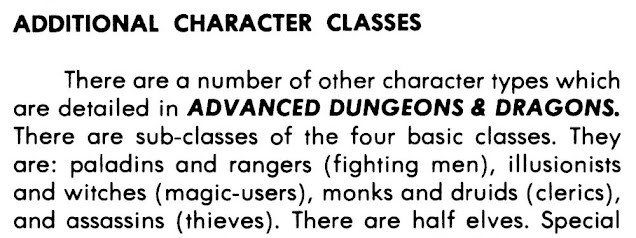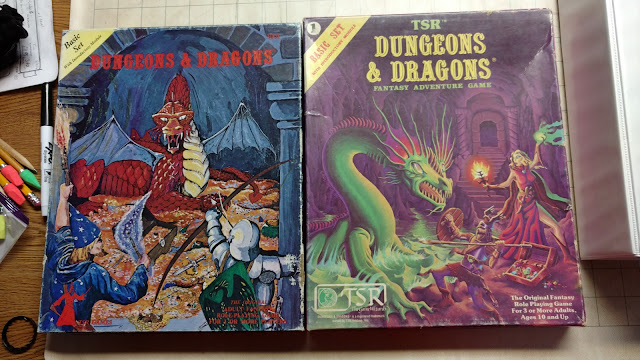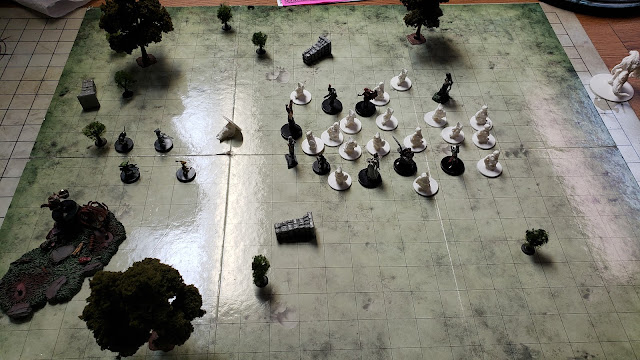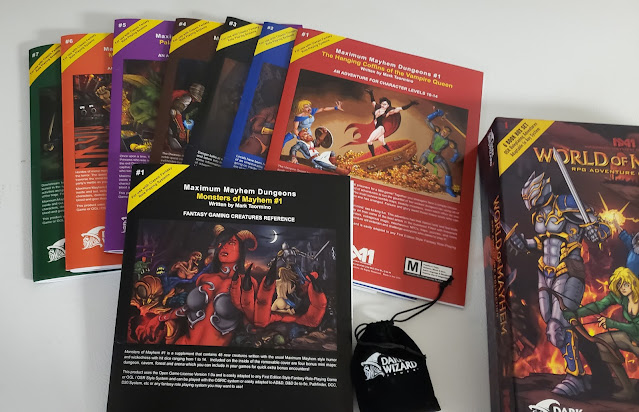Since 2001, Reviews from R’lyeh have contributed to a series of Christmas lists at Ogrecave.com—and at RPGaction.com before that, suggesting not necessarily the best board and roleplaying games of the preceding year, but the titles from the last twelve months that you might like to receive and give. Continuing the break with tradition—in that the following is just the one list and in that for reasons beyond its control, OgreCave.com is not running its own lists—Reviews from R’lyeh would once again like present its own list. Further, as is also traditional, Reviews from R’lyeh has not devolved into the need to cast about ‘Baleful Blandishments’ to all concerned or otherwise based upon the arbitrary organisation of days. So as Reviews from R’lyeh presents its annual (Post-)Christmas Dozen, I can only hope that the following list includes one of your favourites, or even better still, includes a game that you did not have and someone was happy to hide in gaudy paper and place under that dead tree for you. If not, then this is a list of what would have been good under that tree and what you should purchase yourself to read and play in the months to come.
—oOo—
 Ancestry & Culture: An Alternative to Race in 5eArcanist Press
Ancestry & Culture: An Alternative to Race in 5eArcanist Press ($24.95/£18.50)There can be no doubt that 2020 has been a fractious year and a year in which no subject matter has been more contentious than that of Race. So it was inevitable that questions about ‘Race’ and the stereotypes that the concept of ‘Race’ in roleplaying games such as
Dungeons & Dragons enforces would be asked. Does a Gnome always live the forest and have an affinity for illusion magic? Does a Dwarf always have a beard, hate Goblins, and be trained as a smith, stonemason, or brewer? Why are there only Half-Orcs and Half-Elves? On the one hand, the answer is ‘yes’, because that is the way that it has always been—and in your
Dungeons & Dragons campaign, there is nothing wrong in keeping it that way. On the other hand, the answer is a firm ‘no’. If you want your half-Orc to grow up amongst Halflings and have led a gentler life, or your character to have an Elf father and a Tielfling mother, than that is equally as acceptable.
Ancestry & Culture: An Alternative to Race in 5e is a supplement which explores and addresses the issue of ‘Race’ in
Dungeons & Dragons, Fifth Edition, providing options for you to create and play the types of characters that not only break the mold set by almost fifty years of
Dungeons & Dragons history, but are the types of character you want to play.
 Alien The Roleplaying Game – Starter SetFree League Publishing
Alien The Roleplaying Game – Starter SetFree League Publishing ($54.50/£39.99)Few starter sets for any roleplaying game come as packed as that for
Alien The Roleplaying Game, the ‘Blue Collar’ Science Fiction-Horror roleplaying based on the films
Alien,
Aliens, and more. A rulebook, a complete scenario in ‘Chariot of the Gods’, a full-colour double-sided map showing charted space and starship plans, plus reference cards and counters, everything necessary to play a game of existential dread and horror in the isolation of deep space, all complicated by the personal agendas of the crew. Not only is the
Alien The Roleplaying Game – Starter Set well appointed, it is superbly illustrated, in turns creepy and horrifying, and its mechanics—a variant of Free League Publishing’s Year Zero system—are designed to drive Player Character Stress up and up, first into hypercompetence, and then into panic and dread. Panic and dread that can spread and escalate… Lastly, the
Alien The Roleplaying Game – Starter Set can be used to run
Destroyer of Worlds, a scenario involving the Colonial Marines.
 Six Seasons in Sartar: A Campaign for RuneQuest: Roleplaying in GloranthaChaoisum, Inc.
Six Seasons in Sartar: A Campaign for RuneQuest: Roleplaying in GloranthaChaoisum, Inc. ($39.95/£29.99)2020 was a great for the
Jonstown Compendium, Chaosium, Inc.’s community content programme for
RuneQuest: Roleplaying in Glorantha and other roleplaying games set in Glorantha. One of the best is
Six Seasons in Sartar: A Campaign for RuneQuest: Roleplaying in Glorantha, a complete introductory campaign set in Glorantha designed to take characters from children through initiation and into their first few seasons as adults among an isolated clan in Sartar. It is also a complete description of this clan and the Player Characters’ place in it, an initiation for the Player Characters, their players, and the Game Master into the mysteries of Glorantha, and more. Fundamentally though, it is a campaign which takes the players and their characters step-by-step into the setting of Glorantha before forcing them into a confrontation with events from wider world beyond their vale.
Six Seasons in Sartar: A Campaign for RuneQuest: Roleplaying in Glorantha is a fantastic introduction to a fantastic world, one of the first titles a prospective Game Master of
RuneQuest: Roleplaying in Glorantha should purchase from the Jonstown Compendium.
 FATE of CthulhuEvil Hat Games
FATE of CthulhuEvil Hat Games ($39.99/£29.99)The influence of the Cthulhu mythos continues to ripple through the gaming hobby to spread and warp the options available when it comes to Lovecraftian investigative roleplaying. When it reached
FATE Core, it did something completely different. It combined the Cthulhu Mythos with a ‘going back in time to save the world’ plot
a la The Terminator not once, not twice, but five times! In
FATE of Cthulhu, the End Times have come about and the survivors have made sacrifices to Yog-Sothoth to be able to go back before the disaster which befell humanity and perhaps foil its most twisted members in their attempt to welcome their inhuman masters back into the world. Whether it is Cthulhu, Dagon, Shub-Nigggurath, Nyarlathotep, or the King in Yellow,
FATE of Cthulhu includes five timelines—or campaigns—which the investigators must go back to and disrupt the five events of which lead up to each of the Old One’s calamitous appearance, in the process facing not just the sanity-draining revelations of the true nature of the cosmos and mankind’s place in it, but also the potentially, physically corruptive effect of being exposed to it.
FATE of Cthulhu is a more action-orientated, more direct, and more upfront about its confrontation with the forces of the Mythos and all the more refreshing for it.
 Cyberpunk REDR. Talsorian Games Inc.
Cyberpunk REDR. Talsorian Games Inc. ($60/£45)Forty years after the publication of
Cyberpunk 2.0.2.0., the classic Cyberpunk roleplaying game returns in the form of
Cyberpunk RED, set three decades before the computer roleplaying game,
Cyberpunk 2077, also released this year. As well as improving and streamlining the mechanics—still familiar from the previous editions of the game—
Cyberpunk RED pushes the timeline on two decades, into a post-mega-corp future where nation states are pushing back against rampant corporate influence, but the world, and the punk on the street, still has to deal with the fallout (sometimes literally) from the Fourth Corporate War. Solos still provide jacked up, cybered muscle and cyber-eye targeting handguns to bring force and leverage to a situation, Media reports and now ‘makes’ the (fake) news, Execs represent cooperate interests, and Netrunners jack in and hack the post-NET world to steal data, sabotage, monitor, and more.
Cyberpunk RED provides background, cyberware, streamlined and updated rules, solid advice on running the game and game types, and more to run a campaign on the edge, in a book which will look as good on the coffee table as on your shelf.
 MÖRK BORG Artpunk RPGFree League Publishing
MÖRK BORG Artpunk RPGFree League Publishing ($39.99/£27.99)Stripped back to a stark brutalism,
MÖRK BORG is a pitch-black pre-apocalyptic fantasy roleplaying game which brings a Nordic death metal sensibility to the Old School Renaissance. At the end of the world, there is one last dark age before all of the miseries come to pass as predicted by The Two-Headed Basilisks in which Fanged Deserters, Gutterborn Scum, Esoteric Hermits, Heretical Priests, Occult Herbmasters, and Wretched Royalty pick over the last remnants of civilisation on an island surrounded by an icy sea and as rotten as they are, make last grasps at heroism and their humanity, undertaking strange missions and tasks from the high and mighty, from The Two-Headed Basilisks’ gothic cathedral in Galgenbeck and Blood-countess Anthelia’s limestone palace, to the fields of death in Graven-Tosk and the barren wastes of Kergüs. From the doomed setting to the ultra-light mechanics, all of
MÖRK BORG is wrapped up in vibrant washes of neon colour, splashes of sticky red blood, and stabs of polished silver, in what is an anguished scream of a game.
 An Inner Darkness: Fighting for Justice Against Eldritch Horrors and Our Own Inhumanity is a Call of CthulhuGolden Goblin Press
An Inner Darkness: Fighting for Justice Against Eldritch Horrors and Our Own Inhumanity is a Call of CthulhuGolden Goblin Press ($35/£25.99)Like the superlative
Harlem Unbound: A Sourcebook for the Call of Cthulhu and Gumshoe Roleplaying Games—arguably the best supplement of 2017—before it,
An Inner Darkness is a supplement for
Call of Cthulhu, Seventh Edition which explores the darker side human history during the Jazz Age. Thus, the anthology’s subject matters include child exploitation, sexual assault, mob violence, nativism, religious persecution, and racial discrimination, which is why it carries a Reader Advisory and that despite the fact that it also deals with cosmic horror which can drive the Investigators mad. This is an undeniably an adult, or at least a mature, gamer’s book and is unflinching in its treatment of its subject matters. Never more so that in ‘A Fresh Coat of White Paint’ which draws parallels between the treatment of immigrants now and then, ‘A Family Way’ which forces the investigators to confront the terrible consequences of sexual assault, and in ‘Fire Without Light’ that explores the aftermath of the Tulsa Race Riots of 1921. All six scenarios are uncomfortable to both run and play, forcing Keeper and player alike to confront the horror of our actual history as well as the horror of the Mythos. They should be no less memorable for either the history or the horror.
 Mausritter
Mausritter*
Games Omnivorous ($25/£20)
Mausritter is a little game about little heroes in a big world. In this rules-light fantasy adventure role-playing game, each player character is a brave mouse adventurer, faced with a dangerous world in which there is threat to mouse-kind under every log and in every bush. Rush nose-first into every situation, and a mouse is sure to come to a short, but nasty end. By being clever and brave and lucky, a mouse can overcome the dangers the world presents to him, find a solution to the problem threatening his community, and perhaps become a hero in doing so.
Mausritter is fast to set-up and fast to play—all too fast if a mouse is foolish, or just plain unlucky—and presents a world we recognise from above, which become a big challenge from below when faced at mouse scale. As well as simple mechanics,
Mausritter employs an innovative inventory system which streamlines what and how many things a mouse is carrying and brings a clever mechanical effect into play when a mouse suffers from conditions such as Hungry or Injured. The
Mausritter book also includes an adventure location to explore and a mouse kingdom base a campaign in. All wrapped up in a totally charming little book.
* (In the interests of transparency, I did edit the new edition of
Mausritter.)
 Valley of PlentyChaosium, Inc.
Valley of PlentyChaosium, Inc./Troupe Games ($35/£25.99)2020 was a great for the
Jonstown Compendium, Chaosium, Inc.’s community content programme for
RuneQuest: Roleplaying in Glorantha and other roleplaying games set in Glorantha. One of the best is
Six Seasons in Sartar: A Campaign for RuneQuest: Roleplaying in Glorantha, a complete introductory campaign set in Glorantha designed to take characters from children through initiation and into their first few seasons as adults among an isolated clan in Sartar. However, the Jonstown Compendium was so good that it did it all over again with
Valley of Plenty, a starter campaign not for
RuneQuest: Roleplaying in Glorantha, but for
QuestWorlds (previously known as and compatible with
HeroQuest: Glorantha), but very much still set in Sartar. The first part of The Jaldonkillers Saga, which will take the player characters from the idyll of their childhood through the sundering of their tribe and beyond to its reconstitution in exile and then the efforts made to retake both their tribe’s lands and glory. Use of the
QuestWorlds mechanics enables the campaign to narratively scaled to the characters and the campaign is very well supported in terms of its background and setting. This is another great introduction to roleplaying in Glorantha, which takes both players and their characters step-by-step into the setting, its mythology, and drama.
 Aliens: Another Glorious Day in the CorpsGale Fore Nine, LLC
Aliens: Another Glorious Day in the CorpsGale Fore Nine, LLC ($60/£44.99)
Aliens: Another Glorious Day in the Corps—or just another bug hunt—puts the players in command of Vasquez, Hicks, Ripley, and others, colonial marines or civilians as they land on and then investigate the strangely empty facility of Hadley’s Hope, looking for survivors, and answers… All too quickly they find out what happened as swarms of relentless monsters from hell which capture you for who knows what reason, have acid for blood, and if not capturing you, then ripping you apart, erupt from the walls and swarm towards you. The colonial marines are trained for anything, but not this and they had better keep their cool and stay frosty in this tense, co-operative, tactical standoff against an implacable, alien foe. The players work together against the board, whether on a bug hunt, or one of several missions which form a campaign.
Aliens: Another Glorious Day in the Corps is richly appointed with reversable maps, character cards for members of the Aliens cast, equipment, and more, including miniatures for Ripley, Newt, five of the colonial marines, and xenomorphs.
Aliens: Another Glorious Day in the Corps brings the science fiction-horror of
Aliens to the table and lets you play out the tense standoff and cat and mouse action horror of the film.
 Vaesen – Nordic Horror RoleplayingFree League Publishing
Vaesen – Nordic Horror RoleplayingFree League Publishing ($55/£39.99)Based on the work of Swedish illustrator and author Johan Egerkrans,
Vaesen – Nordic Horror Roleplaying takes you into a dark Gothic setting of the nineteenth century, one steeped in Nordic folklore and old myths of Scandinavia. Long have the vaesen—familiars, nature spirits, shapeshifters, spirits of the dead, and other monsters lived quietly alongside mankind, for mankind knew their ways and the vaesen understood ours, but as the century wanes, the Mythic North is changing. The young are moving to the cities, the cities are industrialising, and the old ways are being forgotten, but not by the vaesen—and they are becoming unruly and dangerous. As members of the newly refounded The Society, the player characters have the gift of the Sight, able to see the vaesen and despite all possessing their own dark secrets have decided to band together and protect mankind against the threat posed by the vaesen. Whatever mystery presents itself to them, whatever horror or suspense they must suffer, the player characters must find a solution to the disruption caused by the vaesen, a solution that requires means other than brute force.
Vaesen – Nordic Horror Roleplaying is a beautiful game, oozing atmosphere and hiding secrets for the player characters to discover, secrets forgotten in this very modern, industrial age.
 Dissident WhispersThe Whisper Collective
Dissident WhispersThe Whisper Collective/
Tuesday Night Games ($30/£25)
Dissident Whispers is an anthology of fifty-eight two-page adventures for roleplaying games as diverse as
Basic/Expert Dungeons & Dragons,
The Black Hack,
Dungeon Crawl Classics,
Dungeons & Dragons, Fifth Edition,
Electric Bastionland,
Mausritter,
MÖRK BORG,
Mothership Sci-Fi Horror RPG,
Trophy Gold,
Troika!,
The Ultraviolet Grasslands, and more, including many systems neutral adventures. It has been put together by an international and diverse range of authors, designers, editors, and illustrators. So it includes ‘Graktil – The Citadel that Crawls’, a hallowed scorpion corpse turned mobile goblin fortress; ‘Snake Temple Abduction’, the partly flooded dungeon home to a medusa queen; and ‘Necropolis of Pashtep’, an Aztec-themed puzzle dungeon. For the
Mothership Sci-Fi Horror RPG, ‘Hideo’s World’ turns the player characters virtual, whilst ‘Flails Akimbo’ for
MÖRK BORG has the player character wake up with their weapons nailed to their hands, and… There is so much to dig into in
Dissident Whispers, in truth not all of it necessarily the best quality. However, there are plenty of adventures here that are worth the price of admission and of the adventures that are not worth that, there are many here that are worth rescuing or plundering for ideas. Last and best of all, every purchase of
Dissident Whispers goes towards the support of the Black Lives Matter movement.
 The Warlock! Compendium is the first supplement for Warlock!, the Old School Rennaisance-like Career and skills roleplaying game whose inspiration is a hybrid of Fighting Fantasy a la The Warlock of Firetop Mountain and Warhammer Fantasy Roleplay. Published by Fire Ruby Designs, it complies the first four expansions for Warlock!, each of which adds flavour and detail to the core rules, particularly when it comes to Careers and magic. In turn, adds new Careers for the non-human races of the Kingdom—or wherever the Game Master’s campaign is set, new magic, rules for magic from old body parts, and rules for what happens if you entreat the unholy powers.
The Warlock! Compendium is the first supplement for Warlock!, the Old School Rennaisance-like Career and skills roleplaying game whose inspiration is a hybrid of Fighting Fantasy a la The Warlock of Firetop Mountain and Warhammer Fantasy Roleplay. Published by Fire Ruby Designs, it complies the first four expansions for Warlock!, each of which adds flavour and detail to the core rules, particularly when it comes to Careers and magic. In turn, adds new Careers for the non-human races of the Kingdom—or wherever the Game Master’s campaign is set, new magic, rules for magic from old body parts, and rules for what happens if you entreat the unholy powers.
